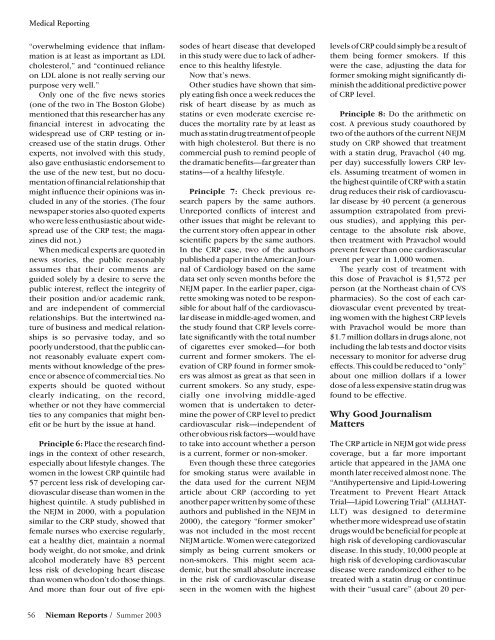summer-2003-Part 2-live - Nieman Foundation - Harvard University
summer-2003-Part 2-live - Nieman Foundation - Harvard University
summer-2003-Part 2-live - Nieman Foundation - Harvard University
- No tags were found...
You also want an ePaper? Increase the reach of your titles
YUMPU automatically turns print PDFs into web optimized ePapers that Google loves.
Medical Reporting“overwhelming evidence that inflammationis at least as important as LDLcholesterol,” and “continued relianceon LDL alone is not really serving ourpurpose very well.”Only one of the five news stories(one of the two in The Boston Globe)mentioned that this researcher has anyfinancial interest in advocating thewidespread use of CRP testing or increaseduse of the statin drugs. Otherexperts, not involved with this study,also gave enthusiastic endorsement tothe use of the new test, but no documentationof financial relationship thatmight influence their opinions was includedin any of the stories. (The fournewspaper stories also quoted expertswho were less enthusiastic about widespreaduse of the CRP test; the magazinesdid not.)When medical experts are quoted innews stories, the public reasonablyassumes that their comments areguided solely by a desire to serve thepublic interest, reflect the integrity oftheir position and/or academic rank,and are independent of commercialrelationships. But the intertwined natureof business and medical relationshipsis so pervasive today, and sopoorly understood, that the public cannotreasonably evaluate expert commentswithout knowledge of the presenceor absence of commercial ties. Noexperts should be quoted withoutclearly indicating, on the record,whether or not they have commercialties to any companies that might benefitor be hurt by the issue at hand.Principle 6: Place the research findingsin the context of other research,especially about lifestyle changes. Thewomen in the lowest CRP quintile had57 percent less risk of developing cardiovasculardisease than women in thehighest quintile. A study published inthe NEJM in 2000, with a populationsimilar to the CRP study, showed thatfemale nurses who exercise regularly,eat a healthy diet, maintain a normalbody weight, do not smoke, and drinkalcohol moderately have 83 percentless risk of developing heart diseasethan women who don’t do those things.And more than four out of five episodesof heart disease that developedin this study were due to lack of adherenceto this healthy lifestyle.Now that’s news.Other studies have shown that simplyeating fish once a week reduces therisk of heart disease by as much asstatins or even moderate exercise reducesthe mortality rate by at least asmuch as statin drug treatment of peoplewith high cholesterol. But there is nocommercial push to remind people ofthe dramatic benefits—far greater thanstatins—of a healthy lifestyle.Principle 7: Check previous researchpapers by the same authors.Unreported conflicts of interest andother issues that might be relevant tothe current story often appear in otherscientific papers by the same authors.In the CRP case, two of the authorspublished a paper in the American Journalof Cardiology based on the samedata set only seven months before theNEJM paper. In the earlier paper, cigarettesmoking was noted to be responsiblefor about half of the cardiovasculardisease in middle-aged women, andthe study found that CRP levels correlatesignificantly with the total numberof cigarettes ever smoked—for bothcurrent and former smokers. The elevationof CRP found in former smokerswas almost as great as that seen incurrent smokers. So any study, especiallyone involving middle-agedwomen that is undertaken to determinethe power of CRP level to predictcardiovascular risk—independent ofother obvious risk factors—would haveto take into account whether a personis a current, former or non-smoker.Even though these three categoriesfor smoking status were available inthe data used for the current NEJMarticle about CRP (according to yetanother paper written by some of theseauthors and published in the NEJM in2000), the category “former smoker”was not included in the most recentNEJM article. Women were categorizedsimply as being current smokers ornon-smokers. This might seem academic,but the small absolute increasein the risk of cardiovascular diseaseseen in the women with the highestlevels of CRP could simply be a result ofthem being former smokers. If thiswere the case, adjusting the data forformer smoking might significantly diminishthe additional predictive powerof CRP level.Principle 8: Do the arithmetic oncost. A previous study coauthored bytwo of the authors of the current NEJMstudy on CRP showed that treatmentwith a statin drug, Pravachol (40 mg.per day) successfully lowers CRP levels.Assuming treatment of women inthe highest quintile of CRP with a statindrug reduces their risk of cardiovasculardisease by 40 percent (a generousassumption extrapolated from previousstudies), and applying this percentageto the absolute risk above,then treatment with Pravachol wouldprevent fewer than one cardiovascularevent per year in 1,000 women.The yearly cost of treatment withthis dose of Pravachol is $1,572 perperson (at the Northeast chain of CVSpharmacies). So the cost of each cardiovascularevent prevented by treatingwomen with the highest CRP levelswith Pravachol would be more than$1.7 million dollars in drugs alone, notincluding the lab tests and doctor visitsnecessary to monitor for adverse drugeffects. This could be reduced to “only”about one million dollars if a lowerdose of a less expensive statin drug wasfound to be effective.Why Good JournalismMattersThe CRP article in NEJM got wide presscoverage, but a far more importantarticle that appeared in the JAMA onemonth later received almost none. The“Antihypertensive and Lipid-LoweringTreatment to Prevent Heart AttackTrial—Lipid Lowering Trial” (ALLHAT-LLT) was designed to determinewhether more widespread use of statindrugs would be beneficial for people athigh risk of developing cardiovasculardisease. In this study, 10,000 people athigh risk of developing cardiovasculardisease were randomized either to betreated with a statin drug or continuewith their “usual care” (about 20 per-56 <strong>Nieman</strong> Reports / Summer <strong>2003</strong>
















